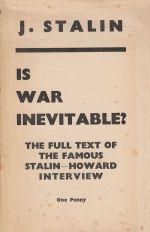
Roy Wilson Howard (January 1, 1883—November 20, 1964) was an innovator in the globalization of modern journalism, a news executive who never lost his appetite for a good story or scoop on his competition. He progressed steadily from cub reporter to his first management appointment at the Publishers Press Association news agency when purchased by his employer, Scripps-McRae. PPA was subsequently consolidated into United Press, where he was appointed vice president and general manager in 1912. There he expanded international coverage, breaking the news of the Armistice four days early; and conducted interviews of leading political figures—continuing to do so throughout his career, as with Stalin, here. Howard was Chairman of the Board of Scripps-Howard (replacing the Scripps-McRae name in 1925) from 1921 to 1936 and president from 1936 to 1952. More on Howard's life and career is available at the Indiana University School of Journalism1.
Howard was in Paris when he decided he should interview Stalin.2 He requested an audience through the U.S. Embassy in Moscow; by the time he arrived via train, word awaited that Stalin would see him that Sunday, March 1st.
The interview was somewhat of a sparring match. Stalin admitted that true Communism had not been adopted in the Soviet Union. When Stalin complained of broken pledges, Howard pressed him with more questions. Stalin proffered not remembering the American Communists Brower and Darcy calling for the overthrow of U.S. capitalism in his presence; and he protested absurdity regarding contentions the Soviets had not lived up to the terms of the Litvinov–Roosevelt agreement by which the U.S. established diplomatic relations with the USSR in 1933—whereby the USSR agreed to prohibit (Communist) agitation against the (bourgeoisie) U.S. on its territory.3 Nonetheless, the official version of the interview as released by Umansky4 appears to give Stalin the upper hand.
As reported in TIME, the interview was a cause for concern for the Soviets as it called attention to the USSR flaunting the terms under which the U.S. granted it recognition. The U.S. Congress had long since determined as much, having refused to appropriate $1,000,000 for U.S. Embassy and Consular buildings in Moscow. Per TIME: the "pledges were nothing but a trap to catch recognition and that, recognition having been caught, they became scraps of paper." Shortly after the interview, Litvinov cut off any more talk of the matter, declaring: "The question of Communist propaganda is a stale subject about which there should be no further discussion."
With regard to critical reception of the interview, there is Trotsky's incredulity-laced commentary.5. On the other hand, scholars generally viewed as Stalin apologists6 such as Yuri Zhukov (local bosses resented the idea7) and J. Arch Getty (a "democratic" project8) take Stalin's words at face value regarding democratization of the U.S.S.R. in the then upcoming revised Soviet constitution, which was to grant universal suffrage by secret ballot.
Howard was of the less sanguine school of thought regarding Stalin's push for democracy; The Communist issue 15 of April, 1936, which reproduced the full text of the interview, criticized Howard for omitting from his publication Stalin's proclamation that the new Soviet constitution would be the "most democratic" in the world.9
| 1 | About Roy W. Howard, retrieved November 13, 2011 |
| 2 | Russia: Brass v. Steel, TIME magazine, Monday, March 16, 1936 edition; interview details taken from that article. |
| 3 | A transcript of the Roosevelt–Litvinov correspondence is available here. |
| 4 | Konstantin Umansky, translator and transcriber for the interview, was head of the Press and Information Department of the Soviet People's Commissariat of Foreign Affairs, for the past five years being the Foreign Office's Chief Censor of all news leaving the USSR. Within several weeks of the interview he left for Washington D.C. to assume his posting as counselor of the Soviet Embassy. Three years later (1939) he was appointed ambassador to the United States. In the first months of WWII he returned to Moscow to work at the foreign ministry. He was appointed ambassador to Mexico in 1943 to improve the Soviet Union's image and concurrently to Costa Rica in 1944. He died in a plane crash in January, 1945 during takeoff from Mexico City traveling to Costa Rica to present his ambassadorial credentials; his death elicited an outpouring of public mourning in Mexico. |
| 5 | Available at www.marxists.org, retrieved November 13, 2011. |
| 6 | Average Joe: The Return of Stalin Apologists, by Tomasz Sommer and Marek Chodakiewicz, available at World Affairs Journal, retrieved November 13, 2011. |
| 7 | viz. The Roots of Perestroika: The Soviet Breakdown in Historical Context, by Sidney I. Ploss, page 62. |
| 8 | viz. Joseph Stalin: An Annotated Bibliography of English-Language Periodical Literature to 2005, by David R. Egan, Melinda A. Egan, page 105. |
| 9 | viz. Egan and Egan, p. 114–115. |
 Gallery
Gallery